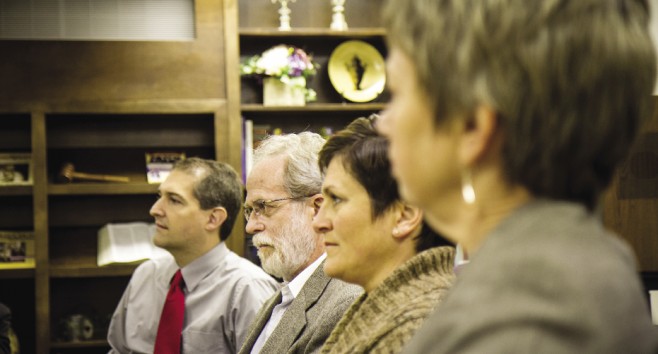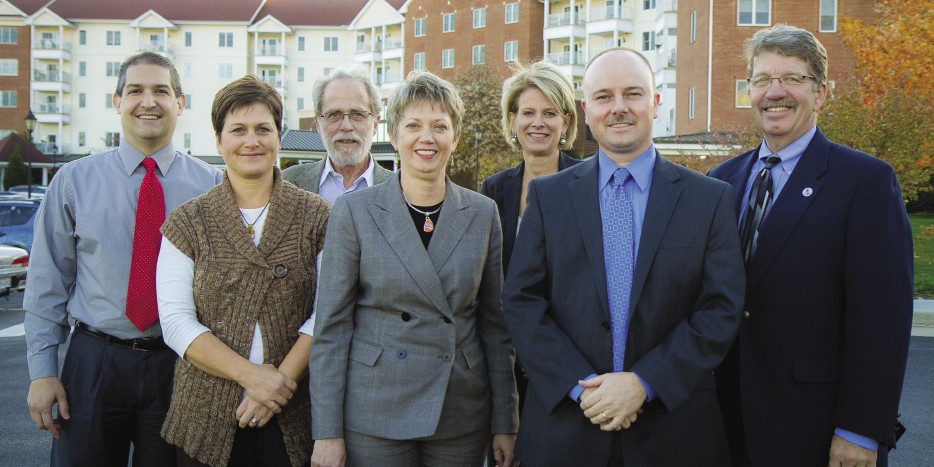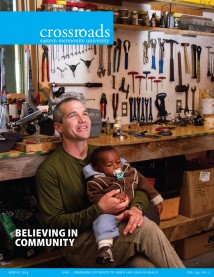
EMU alumni in leading roles at Virginia Mennonite Retirement Community include (from left) Mike Piper ’95, Marv Nisly ’68, Diane Weaver ’91, MBA ’09, and Regina Schweitzer ’78, MBA ’07. (Photos by Jon Styer)
In the first decades of the 20th century, simultaneous efforts arose with the Virginia Mennonite Conference to establish institutions that might sit like bookends at either end of our lives: a school and home for the elderly. The first bit came together relatively quickly, with the school we now know as EMU admitting its first students in 1917.
Progress was considerably slower on the retirement home, though, and it was not for another 37 years – long enough for EMU’s first rosy-cheeked students to go gray themselves – that the Virginia Mennonite Home (VMH) opened on the far side of Park Woods in 1954. Giving EMU a few decades to get its programs up and running was handy in the sense that the new home had a local talent pool to draw from. Dr. Merle Eshleman ’29 split his time as a physician between VMH, EMU and a nearby private practice, while Elizabeth Showalter Martin ’30 was one of the first nurses on its staff. A public address system in the original brick building (since torn down) piped programs from the college out to the residents. A full accounting of the tangled, back-and-forth relationship between EMU and VMRC in those early days would fill books.
When VMH opened, it was the first modern retirement home in the area. With that accomplished, its leaders soon began thinking about ways to keep ahead of the curve. To this end, in 1974 the board of directors asked John R. Mumaw – EMU’s president from 1948 to 1965 – to lead a strategic planning study. Mumaw’s approach was thorough, lasting more than three years, and included tours of other retirement homes as far away as Denmark.
One of the major recommendations in the resulting report was finding ways to make life at VMH seem as normal and non-hospital-like as possible (it is not coincidental that the Virginia Mennonite Home became the cozier-sounding Virginia Mennonite Retirement Community, or VMRC, in 1978).
Realizing that vision for familiar, comfortable care has been a process in the gradual making ever since. It took a major step forward in the spring of 2013, when VMRC opened Virginia’s first Green House® homes, based on a model pioneered in 2003 in Mississippi as a way to care for residents in a setting as home-like as possible. In each of these three new homes, together known as VMRC’s Woodland Park community, about 10 people live together, sharing their meals, their time and, as they are able, their chores, with each other and staff who provide round-the-clock, full nursing care.
Another need highlighted in Mumaw’s report was for affordable housing for the elderly. Within a few years, VMRC broke ground on Heritage Haven, with substantial funding from the U.S. Department of Housing and Urban Development. Completed in 1981, it remains the area’s only federally subsidized housing in a retirement community.
Today, around 730 people live at VMRC, making it the largest of the three major retirement communities in Harrisonburg and Rockingham County. Think about the math for a second (the combined city-county population is in excess of 125,000 people) and the following fact isn’t nearly as surprising as it might first sound: only 10 percent of adults in this country ever move to a retirement community. With an eye toward future growth and continuing to meet the needs of the aging, serving the 90 percent who won’t ever actually move to VMRC is something the organization “really has a mission for,” said Regina Schweitzer ’78, MBA ’06, vice-president for residential living.*
Of note, only a third of VMRC residents are from a Mennonite background, a ratio that’s more or less held constant since the beginning. This is indicative of VMRC’s long-standing intention to serve the entire community, according to president and CEO Judith Reitz Trumbo ’82.
Indoor walkways run between most of the biggest buildings, including a central “Main Street” corridor where one can eat at the café, transact at the bank, go to a doctor’s appointment (the physician’s office at VMRC, a partnership with the Harrisonburg Community Health Center is unique to local retirement homes), tinker in the woodshop and shop at the canteen – commuting by indoor taxi if walking isn’t an option.
“I enjoy that part – that everyone’s connected,” said Shawn Printz, MBA ’04, vice-president for support services at the retirement community.

These current alumni working at Virginia Mennonite Retirement Community are standing on the shoulders of the EMU-linked persons who founded it in 1954 as the first modern retirement home in the area. From left: Mike Piper ’95; Diane Weaver ’91, MBA ’09; Marv Nisly ’68; Regina Schweitzer ’78, MBA ’07; Judith Trumbo ’82; Shawn Printz, MBA ’04; Les Helmuth ’78.
Connections. A full accounting of today’s tangled, back-and-forth relationship between EMU and VMRC would fill even more books. Park Woods is a melting pot, a perfect place for a stroll, with paths leading to VMRC on two sides and openings toward EMU properties on the other two sides. The Wellness Center at VMRC gets heavy use from EMU faculty and staff. The EMU cafeteria represents a nearby dining destination for people who live at VMRC, who also turn out by the busload for basketball games in Yoder Arena. A steady stream of student interns and volunteers flows from the college to the retirement home. A steady stream of people flows, over a longer timescale of human life and aging, from employment at EMU to retirement at VMRC, a stone’s throw to the north. Alumni who work at VMRC regularly rub shoulders with professors who taught them years or decades earlier.
Home runs from EMU’s baseball field rain down toward the backside of Park Place (damages caused but rarely), the building just beyond the left field wall. There was once an old gentleman from VMRC who made it his habit to collect these balls, and when he died, the family passed along the box full of baseballs they found in his apartment to Les Helmuth ’78, executive director of the VMRC Foundation. Well aware of EMU’s budget-conscious approach to extracurriculars, and life in general, Helmuth delivered the box back to the athletics department. Things between them go around, come around.
— Andrew Jenner ’04
* First Choice Home Health, a home healthcare business that VMRC co-owns with the Church of the Brethren-affiliated Bridgewater Retirement Community, is one way VMRC has been serving this mission to the area’s 90-percenters.
